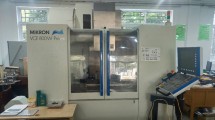Abstract
Flexibly reconfigurable roll forming (FRRF) is a novel sheet metal forming technology in which sheet metal is shaped into the desired curvature using reconfigurable rollers and gaps. However, FRRF has a disadvantage in terms of predicting the forming result because this technology produces two-dimensional curved surfaces from one-dimensional curved lines. A previous study used regression analysis to predict the longitudinal curvature results of the FRRF process. In this study, a prediction model using machine learning was developed. A comparative investigation with an existing regression model was conducted using an artificial neural network (ANN) model based on machine learning. Sample data were obtained via numerical simulation, and the target surfaces were convex and saddle-shaped. To confirm the validity of each model, a goodness-of-fit test was performed. Further, to confirm the predictability of each model, the same amount of random data was extracted and a random sample test was performed. In the case of the saddle-shaped surface, the ANN model showed a predominantly high predictability, but in the case of the convex shape surface, the regression model performed better. The ANN model has potential to be used in practical applications such as skin structure forming for aircraft and shipbuilding.
Similar content being viewed by others
References
Jeswiet J, Geiger M, Engel U, Kleiner M, Schikorra M, Duflou J, Neugebauer R, Bariani P, Bruschi S (2008) Metal forming progress since 2000. CIRP J Manuf Sci Technol 1:2–17
Jang CD, Seo SL, Ko DE (1997) A study on the prediction of deformations of plates due to line heating using a thermal elasto-plastic analysis mode. J Ship Prod 13:22–27
Jang CD, Moon SC, Ko DE (2000) Acquisition of line heating information for automatic plate forming. Proceeding of Ship Structures Committee Symposium, pp 1–6
Park JW, Ku TW, Kim J, Kim KH, Kang BS (2016) Tool fabrication for composite forming of aircraft winglet using multi-point dieless forming. J Mech Sci Technol 30(5):2203–2210
Abebe M, Park JW, Kang BS (2017) Reliability-based robust process optimization of multi-point dieless forming for product defect reduction. Int J Adv Manuf Technol 89:1223–1234
Hu ZQ, Li MZ, Cai ZY, Gong XP (2009) Continuous flexible forming of three-dimensional surface parts using bendable rollers. Mater Sci Eng A 499:234–237
Cai ZY, Li MZ, Lan YW (2012) Three-dimensional sheet metal continuous forming process based on flexible roll bending: principle and experiments. J Mater Process Technol 212:120–127
Kang BS, Yoon JS (2013) Sheet forming apparatus with flexible rollers. KR Patent: 101309228
Liu P, Ku TW, Kang BS (2015) Shape error prediction and compensation of three-dimensional surface in flexibly-reconfigurable roll forming. J Mech Sci Technol 29:4387–4397
Yoon JS, Son SE, Song WJ, Kim J, Kang BS (2014) Study on flexibly-reconfigurable roll forming process for multi-curved surface of sheet metal. Int J Precis Eng Manuf 15(6):1069–1074
Yoon JS, Kim J, Kang BS (2015) Deformation analysis and shape prediction for sheet forming using flexibly reconfigurable roll forming. J Mater Process Technol 233:192–205
Liu P (2015) Process design for flexibly-reconfigurable roll forming and its application using FEM. Ph.D dissertation. Pusan National University
Son SE, Yoon JS, Kim HH, Kim J, Kang BS (2016) Evaluation of formability dependent on reconfigurable roller types for 3D curved sheet forming. Trans Mater Process 25:12–20
Park JW, Yoon JS, Lee KH, Kim J, Kang BS (2017) Rapid prediction of longitudinal curvature obtained by flexibly reconfigurable roll forming using response surface methodology. Int J Adv Manuf Technol 91:3371–3384
Mia M, Khan MA, Dhar NR (2017) Study of surface roughness and cutting forces using ANN, RSM, and ANOVA in turning of Ti-6Al-4Vunder cryogenic jets applied at flank and rake faces of coated WC tool. Int J Adv Manuf Technol 93:975–991
Wang ZH, Gong DY, Li X, Li GT, Zhang DH (2017) Prediction of bending force in the hot strip rolling process using artificial neural network and genetic algorithm (ANN-GA). Int J Adv Manuf Technol 93:3325–3338
Manoochehri M, Kolahan F (2014) Integration of artificial neural network and simulated annealing algorithm to optimize deep drawing process. Int J Adv Manuf Technol 73:241–249
Desai CK, Shaikh A (2012) Prediction of depth of cut for single-pass laser micro-milling process using semi-analytical, ANN and GP approaches. Int J Adv Manuf Technol 60:865–882
Nouioua M, Yallese MA, Khettabi R, Belhadi S, Bouhalais ML, Girardin F (2017) Investigation of the performance of the MQL, dry, and wet turning by response surface methodology (RSM) and artificial neural network (ANN). Int J Adv Manuf Technol 93:2485–2504
Yoon JS (2016) Design and implementation of flexibly-reconfigurable roll forming. Ph.D dissertation. Pusan National University
Funding
This work was supported by the National Research Foundation of Korea (NRF) grant funded by the Korea government (MSIP) through the Engineering Research Center (No. 2012R1A5A1048294). Also, this work was supported by the Human Resource Training Program for Regional Innovation and Creativity through the Ministry of Education and National Research Foundation of Korea (NRF-2015H1C1A1035499).
Author information
Authors and Affiliations
Corresponding author
Rights and permissions
About this article
Cite this article
Park, JW., Kang, BS. Comparison between regression and artificial neural network for prediction model of flexibly reconfigurable roll forming process. Int J Adv Manuf Technol 101, 3081–3091 (2019). https://doi.org/10.1007/s00170-018-3155-7
Received:
Accepted:
Published:
Issue Date:
DOI: https://doi.org/10.1007/s00170-018-3155-7



